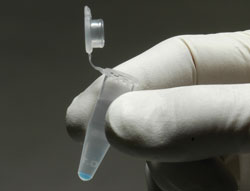Arf6 Pull-down Activation Assay Biochem Kit (bead pull-down format) - 20 Assays
Product Uses Include
- Analysis of in vivo Arf6 activation.
Introduction
The mammalian ADP-ribosylation factor (Arf) subfamily of Ras-related small G-proteins was originally named for the ability to stimulate cholera toxin mediated ADP-ribosylation of the Gsα subunit utilized by many GPCRs (1). The Arf GTPases have been grouped into three classes based on their size and amino acid similarity (2): class I (Arf6 and Arf3), class II (Arf4 and Arf5) and class III (Arf6). One of the primary roles of Arf6 is in protein trafficking from the plasma membrane to endocytic compartments (e.g., GPCRs) and appears to have a role in the anterograde transport of some GPCRs (3, 4). Like Arf1, Arf6 functions in part by the activation of lipid modifying enzymes that alter the local membrane environment (3).
Arf6, like other small G-proteins, cycles between the inactive GDP-bound and the active GTP-bound states. The preferential association of effector proteins with the GTP-bound over the GDP-bound state of Arf6 provides the basis for Arf6’s function in the cell. This highly specific association of effector proteins with Arf6-GTP has been exploited to develop affinity precipitation assays to monitor Arf6 activation (5).
Cytoskeleton’s Arf6 Activation Assay Biochem Kit™ utilizes the Arf6 protein binding domain (PBD) of the effector protein GGA3 (Golgi-localized γ-ear containing, Arf-binding protein 3), which has been shown to specifically bind the GTP-bound form of Arf6 (5, 6). We have covalently conjugated purified GGA3-PBD (amino acids 1-316) expressed in E. coli to the colored sepharose beads provided in this kit (Figure 1). Using these beads, the researcher is able to “pull-down” Arf6-GTP and quantify the level of active Arf6 with a subsequent Western blotting step using the Arf6 specific antibody provided in this kit. This assay provides a simple means of analyzing cellular Arf6 activation levels in a variety of systems. A typical Arf6 pull-down assay is shown in Figure 2 below using either GTPγS and GDP loaded MDCK cell extracts or extracts from MDCK cells that have been harvested and held in suspension or were plated onto fibronectin coated culture dishes (e.g., see references 7, 8).
Kit contents
The kit contains sufficient materials for 20 assays, depending on assay setup, and includes reagents for positive and negative controls. The following components are included:
- GGA3-PBD beads (Cat. # GGA05)
- Arf6 monoclonal antibody (Cat. # ARF06)
- His-tagged Arf6 protein
- GTPγS: (non-hydrolyzable GTP analog) (Cat. # BS01)
- GDP
- Cell lysis Buffer
- Wash Buffer
- Loading Buffer
- STOP Buffer
- Protease inhibitor cocktail (Cat. # PIC02)
- DMSO
- Manual with detailed protocols and extensive troubleshooting guide

Figure 1. The brightly colored glutathione agarose beads in BK033-S makes the kit easy to use.
Example results
A typical Arf6 pull-down assay is shown in Figure 2 using either GTPγS and GDP loaded MDCK cell extracts or extracts from MDCK cells that have been harvested and held in suspension or were plated onto fibronectin coated culture dishes (e.g., see references 7, 8).
Figure 2. Arf6 Activation Assay Biochem Kit™ Pull-down Assay Results.

Top: MDCK cell lysates (500 µg) loaded with GTPγS (GTP lane) or GDP (GDP lane) using the method described in Section VI: Control Reactions in the product manual.
Bottom: MDCK cell lysates (500 ug) obtained from cells that were either kept in suspension for 2 hours (Sus) or grown on tissue culture plates (Rp). All extracts were incubated with 20 μg of GGA3-PBD beads and processed as described in Section VI: Pulldown Assay in the product manual. All bead samples were resuspended in 20 µl of 2x sample buffer and then separated on a 4-20% SDS-PAGE gel, transferred to PVDF, probed with a 1:250 dilution of anti-Arf6 antibody, and processed for chemiluminescent detection as described in Section VI: STEP 4 in the product manual.
References
- Kahn, R. A., and Gilman, A. G. (1986) The Protein Cofactor for ADP-ribosylation of Gs by Cholera Toxin is Itself a GTP Binding Protein. J. Biol. Chem. 261, 7906-7911.
- Tsuchiya, M., Price, S. R., Tsai, S-C, Moss, J. and Vaughan, M. (1991) Molecular Identification of ADP-Ribosylation Factor mRNAs and Their Expression in Mammalian Cells. J. Biol. Chem. 266, 2772-2777.
- D’Souza-Schorey, C., and Chavrier, P. (2006) ARF proteins: Roles in membrane traffic and beyond. Nat. Rev. Mol. Cell Biol. 7, 347-358.
- Wang, G., and Wu, G. (2012) Small GTPase regulation of GPCR anterograde trafficking. Trends Pharmacol. Sci. 33, 28-34.
- Cohen, L. A., and Donaldson, J. G. (2010) Analysis of Arf GTP-binding protein function in cells. Curr. Protoc. Cell Biol. 48, 14.12.1-14.12.17.
- Takatsu, H., Yoshino, K., Toda, K., and Nakayama, K. (2002) GGA proteins associate with Golgi membranes through interaction between their GGAH domains and ADPribosylation factors. Biochem. J. 365, 369-378.
- Balasubramanian, N., Scott, D. W., Castle, J. D., Casanova, J. E., and Schwartz, M. A. (2007) Arf6 and microtubules in adhesion-dependent trafficking of lipid rafts. Nat. Cell Biol. 9, 1381-1391.
- Goldfinger, L. E., Ptak, C., Jeffery, E. D., Shabanowitz, J., Hunt, D. F., and Ginsberg, M. H. (2006) RLIP76(RalBP1) is an R-Ras effector that mediates adhesiondependent Rac activation and cell migration. J. Cell Biol. 174, 877-888.
Coming soon! If you have any questions concerning this product, please contact our Technical Service department at tservice@cytoskeleton.com





